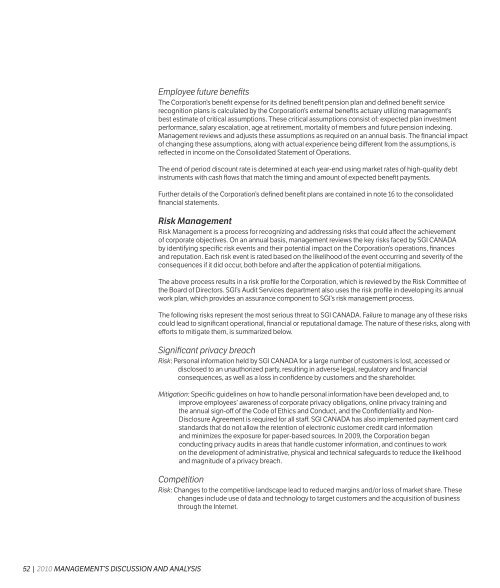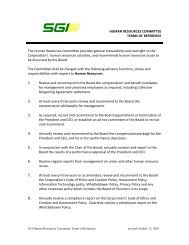Full report - SGI Canada
Full report - SGI Canada
Full report - SGI Canada
You also want an ePaper? Increase the reach of your titles
YUMPU automatically turns print PDFs into web optimized ePapers that Google loves.
Glossary of terms<br />
National Policy 58-201 Corporate Governance Guidelines<br />
Independence<br />
The matter of “independence from management” is based upon the definition set by the Canadian<br />
Securities Administrators (CSA) and utilized by publicly traded companies in the industry. None of the<br />
directors have worked with or for the Corporation, or have direct material contracts or relationships<br />
with the Corporation, or have received remuneration from the Corporation in excess of the fees and<br />
compensation as directors and committee members or as directors of subsidiaries of the Corporation.<br />
However, two members of the Board of Directors are partners in law firms that have performed legal<br />
services for the Corporation in 2010, and are thereby deemed to have a material indirect relationship<br />
with the Corporation under the above standard. The Corporation’s owner has managed this issue<br />
through the development of a protocol regarding lawyers serving on Crown Investments Corporation<br />
subsidiary Crown corporation Boards of Directors. Although not in strict compliance with the CSA<br />
standards, this protocol adopts the principle that directors must be free from any material relationship<br />
that may interfere with the director’s ability to exercise independent judgment in the best interests of<br />
the Corporation or to influence the choice of law firms. Given the smaller local market in Saskatchewan<br />
for legal services, the protocol restricts directors from any direct material relationship, but allows a<br />
limited indirect relationship subject to the qualifications of the protocol, such as pre-approval of legal<br />
services by an independent Board committee, declarations of conflict, no direct benefit to the director<br />
and restriction of information to that director. The Corporation’s General Counsel reviews all charges<br />
related to the provision of legal services by external counsel. The General Counsel in turn <strong>report</strong>s to the<br />
Governance committee of the Board on any new matters undertaken by the director’s law firm, other<br />
than those that are substantially similar to matters previously performed by the law firm in question.<br />
The Board Chair, Warren Sproule, Q.C., and Board member Douglas Richardson, Q.C., are lawyers who<br />
are subject to this protocol. All other directors, including the Vice-Chair of the Board, are independent<br />
of management. At each Board and committee meeting, the directors meet in-camera without the<br />
presence of management.<br />
Broker: A person who negotiates insurance policies on behalf of the insurance company, receiving a<br />
commission from the insurance company for policies placed and other services rendered.<br />
Casualty insurance: One of the three main groups of insurance products (the others are life insurance and<br />
property insurance). This type of insurance is primarily concerned with losses caused by injuries<br />
to others than the policyholder and the resulting legal liability imposed on the insured.<br />
Catastrophe reinsurance: A policy purchased by a ceding company that indemnifies that company for<br />
the amount of loss in excess of a specified retention amount subject to a maximum specific limit<br />
from a covered catastrophic event.<br />
Cede, Cedant, Ceding company: An insurance company that transfers some or all of the risks in active<br />
policies to another company cedes its business. The company transferring its risks is known as<br />
the cedant or ceding company.<br />
Claims incurred: The totals for all claims paid and related claim expenses during a specific accounting<br />
period(s) plus the changes in IBNR reserve for the same period of time.<br />
Combined ratio: A measure of total expenses (claims and administration) in relation to net premiums<br />
earned as determined in accordance with GAAP. If this ratio is below 100%, there was a profit from<br />
underwriting activities, while over 100% represents a loss from underwriting.<br />
Facility Association: Participation in automobile risk-sharing pools whereby P&C insurance companies<br />
share resources to provide insurance coverage to high-risk individuals or businesses.<br />
GAAP: Generally accepted accounting principles. These are defined in the handbook prepared by the<br />
Canadian Institute of Chartered Accountants.<br />
Gross premiums written (GPW): Total premiums, net of cancellations, on insurance underwritten during a<br />
specified period of time before deduction of reinsurance premiums ceded.<br />
IBNR reserve: Abbreviation for “incurred but not <strong>report</strong>ed.” A reserve that estimates claims that have been<br />
incurred by a policyholder but not <strong>report</strong>ed to the insurance company. It also includes unknown<br />
future developments on claims that have been <strong>report</strong>ed.<br />
Loss ratio (Claims ratio): Claims incurred net of reinsurance expressed as a percentage of net premiums<br />
earned for a specified period of time.<br />
Minimum Capital Test (MCT): A solvency ratio used by regulators to assess a company’s financial strength.<br />
This ratio measures capital requirements in relation to the degree of risk undertaken by a particular<br />
company. The minimum amount required by this ratio, as determined by the regulators, is 1.5 or<br />
150% of capital available over capital required.<br />
Net premiums earned (NPE): The portion of net premiums written that is recognized for accounting<br />
purposes as revenue during a period.<br />
Net premiums written (NPW): Gross premiums written for a given period of time less premiums ceded to<br />
reinsurers during such period.<br />
Net risk ratio (NRR): A ratio of net premiums written to equity. This ratio indicates the ability of a company’s<br />
financial resources to withstand adverse underwriting results. The regulatory guideline is a ratio of<br />
3.0 or lower.<br />
104 | 2010 CORPORATE GOVERNANCE GLOSSARY OF TERMS 2010 | 105















